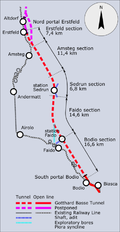This article is about the 2016 railway tunnel. For the 1882 railway tunnel, see Gotthard Tunnel. For the 1980 road tunnel, see Gotthard Road Tunnel.

Turnout at Faido multifunction station
|
|
| Overview | |
|---|---|
| Official name | German: Gotthard-Basistunnel, Italian: Galleria di base del San Gottardo |
| Line | AlpTransit |
| Location | Traversing the central Swiss Alps of Saint-Gotthard Massif (cantons of Uri, Graubünden, and Ticino) |
| Coordinates | 46.600°N 8.765°ECoordinates: 46.600°N 8.765°E |
| Status | Commissioning, commercial services to start December 2016[1] |
| System | Swiss Federal Railways (SBB CFF FFS) |
| Start | Erstfeld, canton of Uri (north, 469 m (1,539 ft)) |
| End | Bodio, canton of Ticino (south, 312 m (1,024 ft)) |
| Operation | |
| Work begun | 1996 |
| Opened | 1 June 2016[2] |
| Owner | SBB CFF FFS |
| Operator | SBB Infrastructure |
| Traffic | Railway |
| Character | Passenger, Freight |
| Technical | |
| Length | 151.840 km (94.349 mi)[3] |
| Line length | 57.09 km (35.47 mi)[3] |
| Track length | 57.104 km (35.483 mi) (east tunnel) 57.017 km (35.429 mi) (west tunnel)[3] |
| No. of tracks | 2 single-track tubes[3] |
| Track gauge | 1,435 mm (4 ft 8 1⁄2 in) (standard gauge) |
| Electrified | 15 kV 16.7 Hz |
| Operating speed | up to 250 km/h (160 mph) |
| Highest elevation | 549 m (1,801 ft)[3] |
| Lowest elevation | 312 m (1,024 ft) (south portal)[3] |
| Tunnel clearance | 5.20 m (17.1 ft) top of rail to overhead conductor[3] |
| Grade | 4.055 ‰ (north) / 6.67 ‰ (south)[3] |
| Route map | |
The project consists of two single-track tunnels connecting Erstfeld (Uri) with Bodio (Ticino) and passing below Sedrun (Graubünden). It is part of the AlpTransit project, also known as the New Railway Link through the Alps (NRLA), which includes the Lötschberg Base Tunnel between the cantons of Bern and Valais and the Ceneri Base Tunnel (under construction, scheduled to open late 2020) to the south. It bypasses the Gotthardbahn, a winding mountain route opened in 1882 across the Saint-Gotthard Massif, which is now operating at capacity, and establishes a direct route usable by high-speed rail and heavy freight trains.[10] It is the third tunnel connecting the cantons of Uri and Ticino after the Gotthard Tunnel and the Gotthard Road Tunnel.
The main purpose of the Gotthard Base Tunnel is to increase local transport capacity through the Alpine barrier, especially for freight, notably on the Rotterdam–Basel–Genoa corridor, and more particularly to shift freight volumes from trucks to freight trains. This not only significantly reduces the danger of fatal road crashes involving trucks, but alsos reduce the environmental damage caused by the ever-increasing amount of freight hauled by heavy trucks. The tunnel will provides a faster connection between the canton of Ticino and the rest of Switzerland, as well as between northern and southern Europe, cutting the Zürich–Lugano–Milan journey time for passenger trains by one hour (and from Lucerne to Bellinzona by 45 minutes).[11]
After 64 percent of Swiss voters accepted the AlpTransit project in a 1992 referendum, tunnel construction began in 1996.[12] Drilling operations in the eastern tunnel were completed on 15 October 2010 in a breakthrough ceremony broadcast live on Swiss TV,[13] and in the western tunnel on 23 March 2011. The tunnels' constructor, AlpTransit Gotthard AG, originally planned to hand over the tunnel to Swiss Federal Railways (SBB CFF FFS) in operating condition in December 2016[14] but, on 4 February 2014, the handover date was changed to 5 June 2016 with the commencement of an 850-day opening countdown calendar on the AlpTransit homepage.[2] The total projected cost of the project was 9.8 billion Swiss francs (€8.85 billion, US$10.3 billion[13]) but the final cost exceeded $12 billion.[5] Nine people lost their lives during construction.[15]
Contents
Background
|
|
This article may be confusing or unclear to readers. In particular, Which tunnel does "second (proposed) tunnel" refer to? When was the comment made?. (June 2016) |
To provide a faster and flatter passage through the Swiss Alps, the GBT cuts through the Gotthard Massif some 600 m (2,000 ft) below the older tunnel. On the current track, the Gotthardbahn, only trains up to 1,300 t (1,400 short tons; 1,300 long tons)[18] when using two locomotives or up to 1,500 t (1,700 short tons; 1,500 long tons) with an additional bank engine at the end of the train are able to pass through the narrow mountain valleys and through spiral tunnels climbing up to the portals of the old tunnel at a height of 1,100 m (3,609 ft) above sea level. When the GBT is in full service, standard freight trains



0 Comment to "best love"
Post a Comment